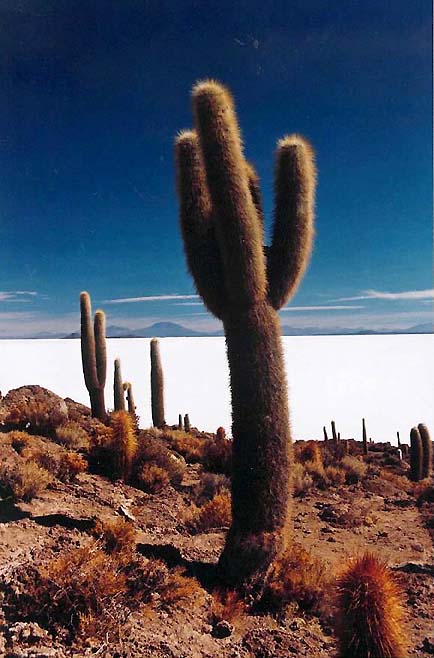Salar
de Uyuni
4
to 6 August, 2004
I don't think many words need be wasted here, as the pictures speak for
themselves. I was often asked, what was the most beautiful place
I saw in South America? Every time I answered without hesitation,
the Salar de Uyuni. The entire 3 day Landcruiser trip from Uyuni,
Bolivia to San Pedro de Atacama, Chile, was filled with one
devastatingly beautiful site after another.

When done in the Bolivia to Chile
direction, the Salar (salt flat) itself is the first destination.
Some prefer to go the other way, saving the Salar until the end, but it
didn't make much difference to me. The largest salt flat in the
world, your eyes get almost snowblinded by the endless whiteness.
Here, a group of Landcruisers from the McSalar company of Colque Tours
gather together to have a lunchtime communion (I personally recommend
Cordillera if you're looking for a company).

Yes, indeed the Salar is in fact a
salt mine as well. Salt miners don't particularly enjoying seeing
tourists hop off their Landcruisers and take photos of them, but
they've gotten used to it. It is terribly photogenic. The
water on the ground was added, because it was dry everywhere on the
Salar. Some guidebooks say that taking the tour during the rainy
season, when a sheet of water covering the salt flats reflects the sky
like a mirror, is especially breathtaking.

When sulfur springs emerge from the
volcanic underground and seeps up onto the surface salt, beautifully
coloured designs wend its way across the Salar like an artist's
palette.

The only island
within the salt flat, the so-called Isla Pescado because of its fish
shape, serves as the first day's lunchbreak picnic spot. Little
nature walks around the island offer scenic views across the Salar.

After the Salar, the
expedition drives through the Siluri desert. The high altitudes
(reaching over 5000m on the 2nd night) and exceptionally clear air
provide a striking visual clarity. The colours leap out of nature
and affix themselves onto your eyes.

The
oft-photographed Arbol de Piedra (stone tree), located in a part of the
Siluri desert with many odd rock formations, beckons at you
mysteriously like a Magritte painting.

Sunset at our first night's
lodging,basic shacks with heavy blankets for the nighttime desert chill.

Toward the Chilean
border, we see a change in terrain. The arid desert gives way to
geysers, hot thermal springs and sumptuous kaleidoscopic lakes.
This Laguna Hedionda (stinky lagoon) does indeed smell of sulfur, but
that doesn't seem to bother the pink flamingos who are wading out
beyond the salt encrusted shore of the lake.

This picture with
faded colours under a clouded sky simply does not do justice to the
breathtaking Laguna Colorada, what I considered the most spectacular
sight of the expedition. The water in the centre of the lake is
blood red (from proprietary algae), something I've never seen anywhere
else. Not too far from here is the Laguna Verde, a lake whose
eerie green colour was taken by NASA to paint on some of their space
capsules. The trip ended in the overrated and overpriced Chilean
tourist town of San Pedro de Atacama, and it would mark my final exit
from Bolivia.
BACK to HOMEPAGE








